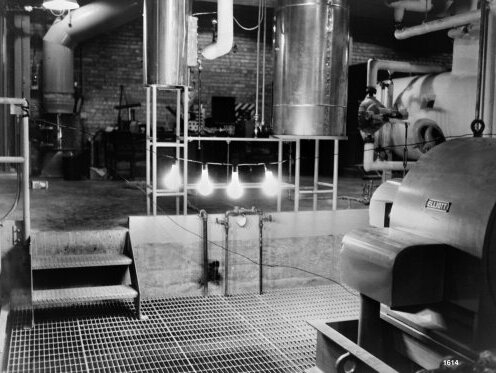 In 1934 the Italian physicist Enrico Fermi produced nuclear fission for the first time for which he received the Nobel Prize for Physics four years later. After receiving his prize, Fermi emigrated to the United States with his Jewish wife, Laura, to escape Mussolini's increasingly anti-semitic fascist regime in his homeland. He worked at Columbia University where he continued experimenting on nuclear fission before joining the project at the University of Chicago constructing the world's first nuclear reactor.
In 1934 the Italian physicist Enrico Fermi produced nuclear fission for the first time for which he received the Nobel Prize for Physics four years later. After receiving his prize, Fermi emigrated to the United States with his Jewish wife, Laura, to escape Mussolini's increasingly anti-semitic fascist regime in his homeland. He worked at Columbia University where he continued experimenting on nuclear fission before joining the project at the University of Chicago constructing the world's first nuclear reactor.
Following America's entry into the Second World War, the experimental work conducted on Chicago Pile-1 became part of the Manhattan Project, which was engaged in creating nuclear weapons. Following the end of the war, development began on more peaceful applications of reactor research, including the generation of electricity. To this end the United States government established the National Reactor Testing Station (NRTS) - now called the Idaho National Laboratory - in the Idaho desert in 1949.
That year construction work began on the Experimental Breeder Reactor 1 (EBR-1) at NRTS. Walter Zinn, who had also worked on the Manhattan Project, and his team at the Argonne National Laboratory designed EBR-1 as an attempt to prove that it was possible to create a breeder reactor rather than to become a working power plant. A breeder reactor is one that creates nuclear fuel at a rate that is greater than it can consume it.
On 24th August 1951 the reactor went critical for the first time. At 1:50pm on 20th December 1951, the power station produced electricity for the first time. It generated enough electricity to illuminate four 200watt light bulbs. The next day the scientists repeated the experiment, producing enough electricity for the EBR-1 building.
Two years later, it successfully began producing fuel as a breeder reactor. Experiments continued on the EBR-1, even after the reactor suffered a partial meltdown in November 1955, until it was deactivated in 1964. The following year EBR-1 became a National Historic Landmark.
To learn more about the reactor see the Experimental Breeder Reactor 1 fact-sheet available as a pdf file from the Idaho National Laboratory site.
Related posts
First French nuclear test: 13th May 1960
Nuclear submarine sank: 22nd May 1968
Nuclear Non-Proliferation Treaty signed: 1st July 1968
Stanislav Petrov averted a nuclear war: 26th September 1983
Customised search for historical information
20 December 2011
On this day in history: Electricity generated by nuclear power for the first time, 1951
Labels:
C20th,
North America,
Science,
Technology
Subscribe to:
Post Comments (Atom)















2 comments:
I have been looking at lot of different sites for good information… But I have found in your blog…& I've gain knowledge and good information from your post thanks.
Thank you for your kind words
Post a Comment